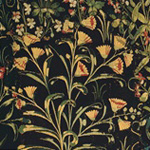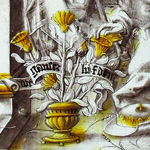 |
 |
 |
The golden flowers of the calendula, said to bloom in every month of the year, figure in the art, literature, and medicine of the Middle Ages. Called “golds” in medieval English, the flowers were associated with the Virgin and came to be known as “marigolds” by the sixteenth century. Above, from left to right: Detail of a large calendula plant, bearing many blooms, which appears below the golden fence enclosing The Unicorn in Captivity; a calendula blooming in December; the daisy-like flower is often shown in profile in medieval depictions, as in this detail of an urn with three calendula flowers shown in the foreground of a silver-stain roundel depicting the Adoration of the Magi.
‘Golde [Marigold] is bitter in savour
Fayr and zelw [yellow] is his flowur
Ye golde flour is good to sene
It makyth ye syth bryth and clene
Wyscely to lokyn on his flowres
Drawyth owt of ye heed wikked hirores
[humours]. . . .Loke wyscely on golde erly at morwe [morning]
Yat day fro feures it schall ye borwe:
Ye odour of ye golde is good to smelle.’???From the herbal of Macer, as quoted in A Modern Herbal
The beautiful golden flowers of Calendula officinalis were much admired by medieval artists and poets. Known simply as “golds” in medieval English and as “goltblum” in German, calendulas did not come to be known as “marigolds” until the late Middle Ages, but their Marian associations predate the designation. Die Goldene Schmiede, a poem in praise of Mary by the thirteenth-century German poet Konrad von W??rzburg, includes calendula among twelve flowers symbolic of the Virgin.
Despite their sacred associations, the brilliant orange-yellow petals had some very humble uses. The were cooked in pottage, and are still known today as ‘pot marigolds.’ They have also been used to give an appetizing yellow color to butter and to cheese, and have been substituted for saffron in cooking. (They impart the color, but not the taste or fragrance of saffron, which is derived from the stigmas of Crocus sativus. (For more on pottage, see “Colewort and Kale,” October 22, 2010.) Medieval herbals recommend calendula to close wounds, cure toothache, and heal ulcers of the stomach and liver. The flowers??were credited with magical powers, and could be used ceremonially to cleanse and to protect.
Marigolds??were also used in garlands, and the sixteenth-century Grete Herbal notes that maidens wore the “fair yellow flowers and ruddy” to feasts or bridals.
???Deirdre Larkin
Sources:
Anderson, Frank J., ed. “Herbals through 1500,” The Illustrated Bartsch, Vol. 90. New York: Abaris, 1984.
Freeman, Margaret B. The Unicorn Tapestries. New York: E. P. Dutton, Inc., 1956.
Grieve, Maude. A Modern Herbal. 1931. Reprint: New York: Dover Publications, 1971.
Tags: Adoration of the Magi, calendula, Crocus sativus, Konrad von W??rzburg, Macer, marigold, pottage, saffron, Unicorn in Captivity
